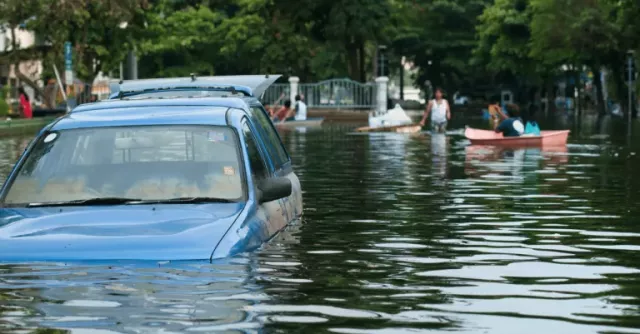Extreme Weather, Climate Change, and Hazard Mitigation

Only now, it seems such events are occurring more often, with greater intensity, and in some highly unusual places. Experts agree the primary reason is human activity that drives global warming and, ultimately, climate change. The result is rising land and water temperatures, rising sea levels, and marked differences in precipitation (less or more). Together, these effects create unprecedented hazard risks and social vulnerabilities for communities nationwide, deepening the need for greater mitigation measures.
According to the U.S. Environmental Protection Agency (EPA), long-term climate changes can directly or indirectly affect many aspects of society in potentially disruptive ways. For example, frequent and intense extreme heat events can lead to illnesses and deaths, cause damage to crops, and reduce water supplies. Conversely, increased participation can support agriculture and replenish water sources, but intense storms can produce strong winds (or tornadoes), lightning, and hail. Such storms can damage property, cause loss of life and population displacement, and temporarily disrupt essential services such as telecommunications, transportation, and energy.
Hazard mitigation planning reduces loss of life and property by minimizing the impact of disasters. It begins with state, local, tribal, and territorial (SLTT) governments identifying natural disaster risks and vulnerabilities common to their specific area. After identifying these risks, they develop long-term strategies for protecting people and property from similar events. Mitigation plans are crucial to breaking the cycle of disaster damage and reconstruction (FEMA).
The National Institute of Building Sciences (NIBS), the nation’s Congressionally chartered convener of experts from the building professions, industry, labor, consumer interests, and government, now believes mitigation saves up to $13 per $1 invested (this is up from $6 in previous years).
Consider Current Events
Temperatures have soared to record highs all summer, and drought conditions, some considered extreme, persist across much of the country. As of this posting, 52 large, active wildfires are burning across Montana, Idaho, Oregon, and several other states. Flooding, on the other hand, is occurring in ordinarily arid locations, including California deserts. And the 2022 Atlantic hurricane season, which is approaching its peak, is expected to be above normal. In fact, forecasters expect a high chance for high-impact hurricanes on the U.S. mainland between now and the season’s end on November 30, 2022.
The recent (July 2022) flooding in eastern Kentucky is also a powerful reminder of Mother Nature’s force and the growing need to mitigate against such hazards. There, 14-16 inches of rain fell over a four-day period, saturating the ground and causing rivers, creeks, and streams to rise to historic levels. Today, the community continues to sift through the debris and mourn the loss of 37 people. Two individuals remain missing.
Sadly, this disaster was the second major one to hit the state in a matter of months. On December 20, 2021, an EF-4 tornado tore through six Kentucky counties, causing more than $148 million in damages and claiming 81 lives. Especially hard hit was the town of Mayfield, where residents continue to reconstruct buildings and their lives to this day.
And who can forget the 2021 Atlantic hurricane season? It was the third most active year on record in terms of named storms and marked the sixth consecutive above-normal season. It was also the first time on record that two consecutive hurricane seasons exhausted the list of 21 named storms.
Heed the Information
To date, and according to the National Oceanic and Atmospheric Administration (NOAA), climate research has yet to show that any given [extreme weather] event was caused solely by global warming. However, over the past decade, research has demonstrated that climate change (specifically due to global warming) has made many extreme events more likely, more intense, longer lasting, or larger in scale than they would have been without it. In fact, for many of the studied events, global warming has been identified as the primary driver, not just a “supporting player.” And several recent studies have concluded that certain heat-related extreme events would not have been possible without human-caused global warming.
Take Action
Given the presence of climate change and the known devastation from recent extreme weather events, it is no longer feasible (or acceptable) to base the probability of future events solely on previous occurrences. Accordingly, all FEMA-approved hazard mitigation plans are required to include an overview of the probabilities of future hazard events. This includes considerations of changing future conditions, like the effects of long-term changes in weather patterns and climate, on the identified hazards impacting a state. It is advised, though not required, that SLTT governments also consider climate change when developing or updating their hazard mitigation plans.
As a reminder, FEMA requires hazard mitigation plans to be updated every five years to remain eligible for certain types of pre-disaster funding. And as a best practice, it’s advantageous to start the process well before your existing plan’s expiration – typically 18-24 months. At BOLDplanning, a division of Preparis, we are confident this will give your organization ample time to engage plan stakeholders, identify hazards, conduct a vulnerability analysis, define a comprehensive (and actionable) mitigation strategy, and gain FEMA’s approval.
Need assistance developing or updating your hazard mitigation plan? BOLDplanning can facilitate the process from start to finish. Email [email protected] to learn more now.


